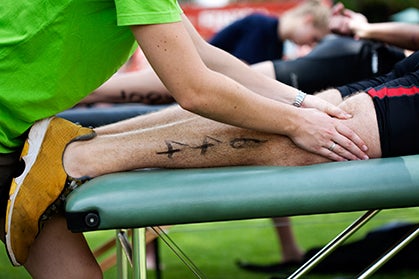Not So Tender Loving Care

When your muscles feel tight, what’s the most natural thing to do? You might say stretch. However, stretching an already tight muscle can cause reactive tension, as the muscle tries to protect itself; since taut muscles already put pressure on their attachments, stretching can damage the tendon and joint. It is more important to identify the root cause of muscle irritation—often, it’s not where you expect—and address it properly.
You’ve probably heard of “trigger points.” The term was coined by Dr. Janet Travell, M.D. to describe small contraction knots in muscle and surrounding tissue (collectively termed myofascia). Trigger points can feel like a partly cooked piece of macaroni buried deep beneath the skin. They are often caused by overuse or overexertion, as in the case of the athlete attempting to run farther or faster—and who among us doesn’t fit that description?
Myofascial irritation is astoundingly common, implicated to some degree in iliotibial band syndrome, plantar fasciitis and other running-related conditions. What’s more, trigger points are notorious for referring pain to parts elsewhere in the body—for example, pain in the quadriceps often radiates to the knee—which can make them difficult to treat. That is, unless you know where to look.
Use the following head-to-toe guide, and with your own fingers and perhaps a trusty massage tool or two, you’ll find myofascial release to be satisfying and healing.
Massage Away Your Pains
Foot Pain/Plantar Fasciitis: Together, the two muscles of the calf (soleus and gastrocnemius) have the power to lift the entire weight of your body, which comes in handy when running trails. But these dense muscles, if irritated, can do as much harm as good. Signs of calf trouble are often felt in the foot, specifically the plantar fascia in the arch. Massage the calf muscles with your opposite knee or with a tool like The Stick. Rather than static pressure, use short, repeated strokes in one direction.
Runner’s Knee: While arthritis and tendonitis are common diagnoses in response to knee pain, often trigger points in the thighs are the real culprits. Runner’s knee—pain around or behind the kneecap—is most commonly caused by the oval bulge of quadriceps muscle on the inside of the thigh just above the knee, known as the vastus medialis. Here, paired thumbs work well for massage. Pay attention to the other quadriceps muscles running along your thigh between your knee and your hip, as you will likely find other hot spots as well.
Hip Pain: Pain and other symptoms of the hip are likely due to the combined effects of more than one muscle. A big culprit is the piriformis, the largest of six short hip-rotator muscles located between your tail bone and thigh bone. A shortened piriformis can compress the sciatic nerve and radiate pain down the back of your legs and into the soles of your feet. To locate the piriformis, feel it contract as you rotate your leg outward while lying on your opposite side, and search the area between the top of your hip bone and your sit bone. Massage the piriformis with a tennis ball or a lacrosse ball, either on the floor or against the wall.
Lower Back: Back pain always has a myofascial component. What’s surprising is that if you look for muscle tension in your lower back, you may never find the real cause of pain. It is actually the gluteus medius—just above your greater hipbone and slightly to the rear—that most often triggers low-back pain. One of the three buttocks muscles, the gluteus medius stabilizes the pelvis. Each time you lift your leg to take a step, the muscle on the opposite side contracts to keep your hip from sagging. “Dead-butt syndrome” commonly affects runners and is a sign of weak glutes. Try a lacrosse ball against a wall and use short, rolling strokes.
Head and Neck: Most of the time neck pain is referred from trigger points in the upper back and shoulders rather than in the neck itself. Pay careful attention to the trapezius, the flat, four-cornered “shrug” muscle located along your upper back, since the “traps” are the most common musculoskeletal cause of headaches and neck pains. Leaning against a ball on the wall is especially effective for massaging this area. Hit the problem areas three to six times per day.
Extra Credit
Be aware that longstanding trigger points often lead to irritation in adjacent muscles, so don’t limit your massage efforts to focal points: spread out. You’ll know you’ve found a “hot spot,” because trigger points are always painful when pressed. Oddly enough, pain level depends more on the degree of trigger-point irritability than on the size of the muscle, as trigger points in some of the tiniest muscles can be downright debilitating.
The pain that comes from massaging a trigger point should be of the pleasant variety, the kind you can relax into, but not so tender as to put you to sleep. Aim for a pain level of seven on a scale of one to 10, and limit massage to roughly 10 strokes per trigger point. If you get no relief from massage, you may be working the wrong spot.
Of course, not all pain is primarily caused by muscle irritation. If sore muscles are accompanied by redness, swelling or joint deformity, visit a sports-medicine physician. And, for a more comprehensive list of muscles and their pain patterns, pick up a copy of Clair Davies’ The Trigger Point Therapy Workbook.
This article originally appeared in our March 2014 issue.